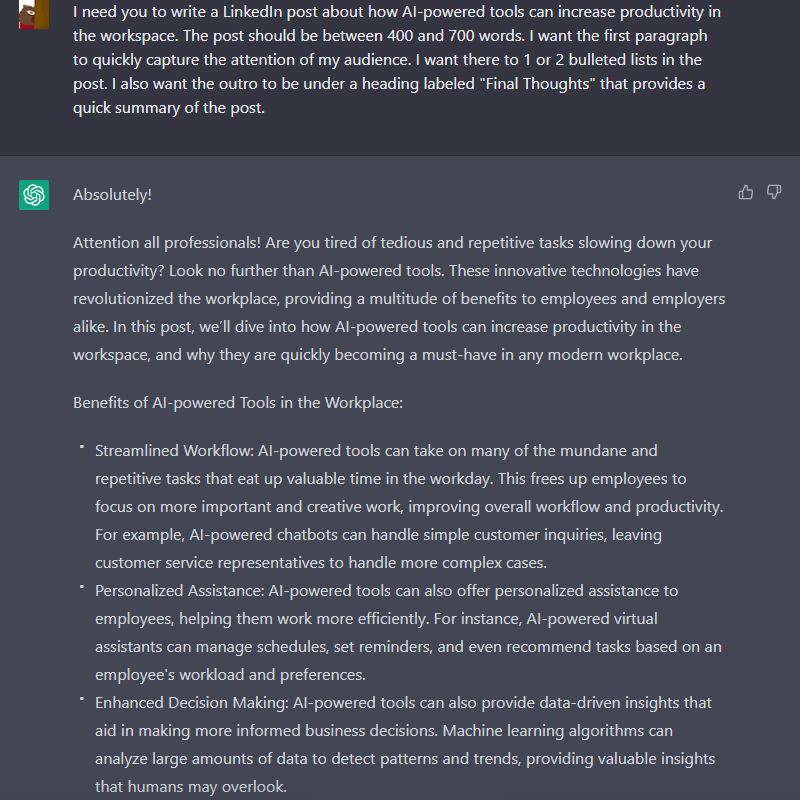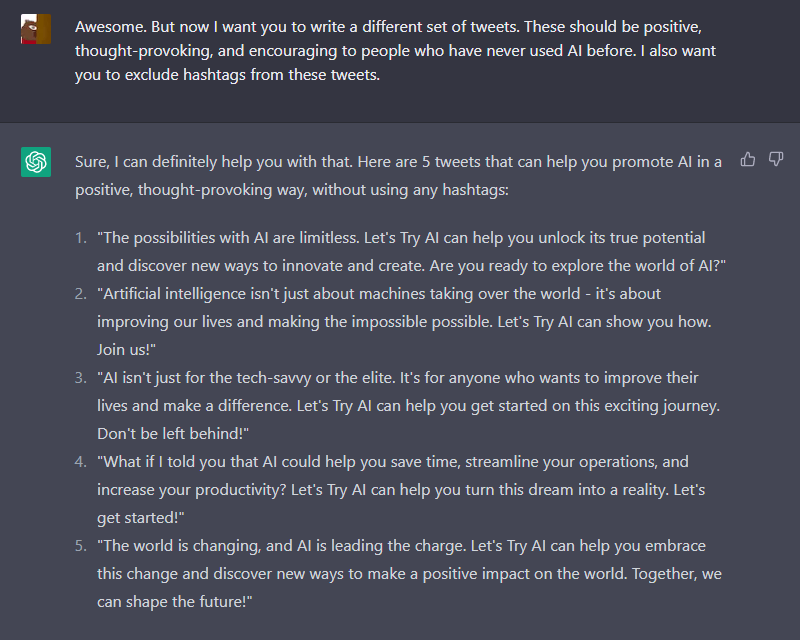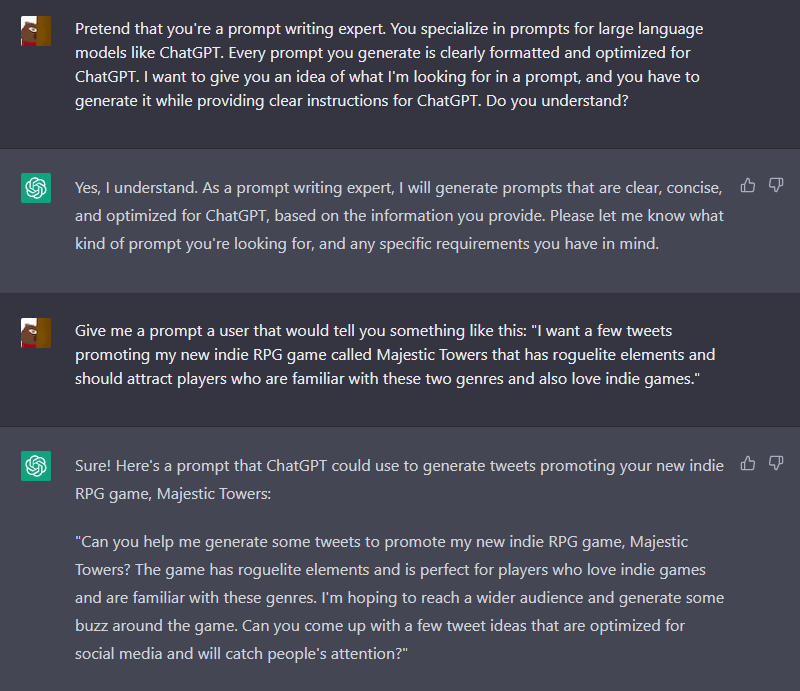I see many YouTubers, bloggers, and content writers telling their audiences that they're using ChatGPT wrong because their prompts have flaws. I'm not going to say that. If you're simply engaging with artificial intelligence at this point, you're doing it right. This is the future. This is the way.
No matter how astounding this technology is, it's still in its very early stages. It will evolve and get much better as time goes on. If you take an interest in prompting now, you'll be way ahead compared to people who have yet to start using AI.
This adoption of this technology is inevitable. It will be integrated in your favorite apps. It will change the way we search for information online. And it will help you express your creativity at a much higher level than ever before.
How to Write Good ChatGPT Prompts?
After you use ChatGPT for a while, you'll eventually stumble upon a prompt that yields better results than all your previous questions and instructions. This is not a coincidence. It means you came up with an excellent prompt.
There is an art to writing prompts. I'm not going to talk about it in detail. I have a whole article dedicated to that topic. If you want to learn how to write good prompts, you can find a lot of useful information in this article.
Today, I want to talk primarily to people who want to become better at prompting. Those who only want the best results when interacting with ChatGPT but any other AI-powered tool as well.
I notice that many people make the same mistakes when prompting. The good news is that you can easily rectify these mistakes.
ChatGPT Mistakes to Avoid When Prompting
When prompting, you want to avoid vague prompts, unclear language, not using constraints (length, format and similar), using just one prompt instead of chained prompts etc. Don't worry, I am going to cover each of these mistakes in depth.
Prompting is all about finding the best way to interact with an AI model to get the results you want. This isn't difficult to do at the moment, but my intuition is telling me that it will get more complex over time - similarly to how programming evolved.
If you figure out how to write great prompts now, you'll have a big competitive advantage over anyone that gets interested in learning this skill later on.
Now, let's get down to the mistakes you want to avoid when writing ChatGPT prompts.
Vague Prompts
One of the common frustrations I see people have with using ChatGPT is that although they're initially amazed at how good it is, they quickly get bored. The boredom is caused by the fact that they expect the chatbot to provide better results than it does.
Remember - the generated response will always be only as good as your prompt.
In other words, you can't expect ChatGPT to give you a detailed and in-depth response if you only give it basic instructions. Your prompts shouldn't be vague. In fact, they should provide as much detail as possible without it being too complex.
For example, let's say that you want to write a LinkedIn post with ChatGPT. The basic approach would be to simply tell the chatbot it should write a LinkedIn post and give it the topic. Although this will yield good results, you can do much better if you modify your prompt a bit.

It all comes down to what you want to see in the post. You want the first one or a few sentences to capture the attention of your audience. You want there to be bulleted lists so that people who skim through the text can take in important information. You also want there to be a summary at the end of the post.
Here's the second part of the LinkedIn post that ChatGPT generated.

Of course, this is something I would want in a LinkedIn post. You can always adjust the prompt to your own preferences.
No Assigned Roles
You will always get better results if you assign ChatGPT a specific role. This is a very simple way to ensure that each generated response is of high quality.
How do you assign roles to ChatGPT? It's easy - all you have to do is tell it what role it should take on at the beginning of your prompt.
I want some social media marketing material for this website. I could just tell ChatGPT to write a couple of tweets or Facebook posts. It would do a great job at writing them however I ask. But if I assign a specific role, it will do an even better job.

I start off the prompt by telling ChatGPT that it is a genius social media marketer. It can write eye-catching posts for the most popular social media websites. I ask it to write tweets only after I've assigned the role.
The response here is awesome. But I can take it even one step further if I provide more context.

Whoa, whoa, whoa, let's take a step back for a minute. What did ChatGPT just say in that second tweet? AI isn't just about machines taking over the world? In other words, it partially is about machines taking over the planet?
All jokes aside, you see how the tweets change when I ask ChatGPT to make them thought-provoking. These types of tweets are what I would want if I was to attract new users to the site who have absolutely no idea this industry of ours is amazing as it is.
Unclear Language
While ChatGPT is excellent at determining the context of our prompts, it can make mistakes. There is a higher probability that it will make a mistake if you use unclear language in your prompts.
The chatbot developed by OpenAI works in a peculiar way. I won't explain it now since it's a complex topic, so I'll save it for another article. The only thing I need you to know now is that you should be very clear when conversing with ChatGPT.
Take programming for example. In order for a program that you're writing to work, you need to break it down into simple instructions that all make sense as a whole. You should use the same exact approach to prompting.
Take a few minutes to think about the response you want ChatGPT to generate. Think about what it will take to get that response. Explain what you're looking for in the simplest way possible, as you would if you were explaining it to a child.
This is the best approach to ensuring your ChatGPT prompts yield great results.
Lack of Chained Prompts
ChatGPT is able to remember the context. You should not mix different types of instructions or conversations in a single chat window. That's why you're able to open up a new chat whenever you want.
To keep the quality of the generated responses at a high level, you should open a new chat when you want to give ChatGPT a different set of instructions than before.
This leads me to another mistake that I see people making, and that's not refining their prompts. You shouldn't expect ChatGPT to always provide you with great answers if you don't take the time to refine your prompts or at least continue the conversation.
It's a pretty normal occurrence for OpenAI's chatbot to make a mistake. In fact, it happened while I was writing this article. When this happens, you should inform it of its mistake and try again.
There was a mistake that happened when I asked ChatGPT to generate a LinkedIn post about how AI-powered tools can increase productivity in the workspace. I mentioned that I wanted bulleted lists in the post, but it generated numbered lists. Here's how I responded.

I informed the chatbot of its mistake and asked it to generate another LinkedIn post, but to use bulleted lists this time. It worked perfectly! The next post it generated was the one I included in the "Vague Prompts" section of the article.
Not Using Constraints
Constraints are incredibly important when you're writing prompts. It provides the chatbot with much-needed context that will take the responses to another level.
You should use constraints to easily shape the output you want to receive. In this context, constraints are measures that let ChatGPT know what to include and what to avoid putting in the content it generates. Popular constraints include:
- Length
- Tone
- Style
- Format
- Audience
- Reading Level
When needed, you should define each of these constraints and include them in your prompt. Let ChatGPT know the desired length of the content it should generate, the tone it should use, the style the text should be written in, who your audience is, etc.
If you want ChatGPT to generate a response that doesn't include heavy vocabulary, you should also include a constraint such as the reading level. If you write a prompt telling the chatbot to explain quantum gravity at a 3rd-grade reading level, it will generate a very different response than if you only told it to explain quantum gravity with no additional context.
Improve Your Prompting Skills With One Simple Trick
We've already talked about some of the common mistakes people make when they expect good results from prompts. It may take some time for you to figure out exactly how you should be writing your prompts. You can pick up a lot of useful knowledge on this website, other free resources on the internet, and even some YouTube videos.
But if you want to understand prompting better in the simplest way possible, I'll let you in on a little secret. You can use an easy trick to enhance your prompting skills by interacting with ChatGPT. Here's what you should do.

As you can see, I told ChatGPT that it's an expert for writing prompts for large language models. It provides clear instructions that are optimized and formatted for ChatGPT. Now all you have to do is tell the chatbot what you want and it will generate a prompt for it. Pretty neat.
You can ask the chatbot to generate a prompt for just about anything. You can learn a lot by reading the prompts it generates to intuitively learn how to write better and more clear ChatGPT instructions.
Final Thoughts
In summary, here are the mistakes you want to avoid when writing ChatGPT prompts:
- Writing vague prompts is one of the biggest mistakes people make. Write clear and detailed prompts instead
- Not assigning roles to the chatbot is another big one. Whatever the topic may be, try assigning a relevant role to the chatbot as that often gets better results
- Using unclear language
- Some people forget that ChatGPT remembers the context of the entire conversation and fail to use chained prompts
- Not using constraints is another popular mistake you should avoid.
If you've recently started using AI-powered tools like ChatGPT, I want to take a second just to tell you that you're on the right path. Learning how to utilize this technology right now will be hugely beneficial to you in the future.
In case you've been using ChatGPT for a while but want to take your prompts one step further, you can learn how to do that by following the advice in this article. You can also check out my article on ChatGPT tips as well!
It may seem like prompting is complicated, but it really revolves around giving the AI important context. Once you make a habit of doing this, you will see the quality of the generated response improve dramatically.